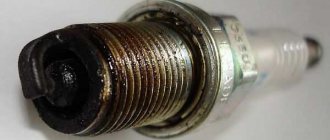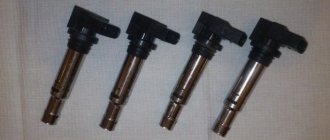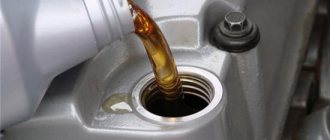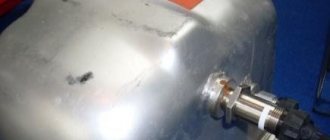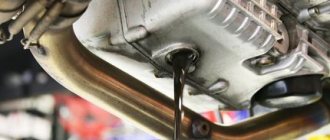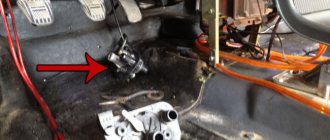It is no secret that for normal operation, an engine requires fluid, or rather fluids, such as motor oil, coolant (antifreeze, antifreeze or water), as well as fuel, due to which the power stroke occurs. I will not go into detail about the role played by each of the above liquids; I think everyone already knows about this to one degree or another. Instead, I want to talk about mixing these liquids, why this happens, what the dangers are and how to avoid this.
Antifreeze in oil - consequences
Such a problem as antifreeze in oil or oil in antifreeze is always unpleasant and always fraught with big troubles. Now you’ll find out which ones. Getting antifreeze into the oil is unacceptable for the reason that any oil has its own viscosity, as well as the necessary set of additives that ensure lubrication of rubbing parts and protect them from corrosion. When antifreeze gets into the oil, it dilutes it, impairing the lubrication of parts and increasing their wear. The appearance of antifreeze in the combustion chamber or oil system can lead to the formation of soot or deposits, which over time will negatively affect the operation of the power unit.
Antifreeze or antifreeze in the oil can also lead to oil starvation by clogging the filter elements, which ultimately impedes the flow of oil into the oil system.
In addition, there is another “side of the coin” - the likelihood of engine overheating due to a decrease in the coolant level. A decrease in the coolant level below the permissible level makes the cooling of the power unit less effective, which can result in engine overheating.
Why is this happening
There are different signs: damage to the oil cooler or a problem with the cylinder head. Contact between the cooling and oil systems occurs only at these points. Some cars need to maintain a specific oil temperature
from seventy-five to eighty-five degrees. Such vehicles are equipped with an oil cooler that interacts with the cooling system, and the coolant is antifreeze.
Oil in the antifreeze indicates that you will need to sort out the oil cooler and fix the problem, or you will have to change everything completely. Lubricating properties are lost, a large load is placed on the engine, which eventually fails. The antifreeze composition contains glycol with toxic indications, so when it gets into the engine lubricant, the potential is destroyed. This leads to blockage of oil molecules and lubricating properties.
Causes and solutions to the problem:
- the head gasket is broken - remove the head and replace the gasket;
- deformation of the head plane – grinding (milling work);
- Poor tightening of bolts - tighten using a torque wrench;
- microcrack in the cylinder block - repair with epoxy paste, clean the surface, weld, weld steel.
The reason for oil getting into the antifreeze is a burnt gasket or a faulty cylinder head itself. This problem comes up when drivers start checking the fluid level. The color and thickness of the coolant changes, the refrigerant develops a pungent odor
. This is the “first call” for the car driver.
Today, ethylene glycol is used as a base for coolants. It is diluted with water in certain proportions, but has the disadvantage of toxicity.
Propylene glycol liquids have a lower boiling point, but better quality, although their production requires more costs.
If the system depressurizes or the pipes are damaged, the engine fluid instantly ends up in the cooling system and vice versa. There are many factors that cause this problem. One of the most important is the inadequacy of the refrigerants used by the driver of the vehicle.
How to detect coolant in oil
The easiest way to detect antifreeze in oil is by reducing the coolant level in the system. If the antifreeze level drops, but there are no leaks anywhere, you should check the oil level, as well as its color and condition, perhaps the antifreeze has gone into the oil.
When checking the engine oil level, it is not difficult to see the antifreeze; it will have a lighter color and will be located above the oil level, and the antifreeze itself will quickly flow down the oil dipstick. Due to dilution with antifreeze, the color of the oil will change towards the color of the coolant.
The second option for checking and detecting antifreeze in oil is the expansion tank. It is necessary to start the engine and increase the speed, while you need to open the tank and see if there are any air bubbles in it. Also, if there is antifreeze in oil or oil in antifreeze, traces of oil will be visible on the walls of the expansion tank. If antifreeze gets into the oil, then after some time the color of the antifreeze itself will also change.
Candles. If antifreeze gets into the oil, the candles will also have soot or a characteristic shade of antifreeze.
When antifreeze gets into oil or oil gets into antifreeze, the color of the exhaust will change; it may become thicker and more concentrated.
Relevant: The engine is taking oil, but you don’t know what’s wrong? We will tell you why the engine consumes oil!
Diagnostics
When the cylinder head gasket
(cylinder head) burns towards the engine compartment, the location of the leak of antifreeze or other liquid from the cooling system can be easily determined by the drip. This is provided that the engine is supervised and washed regularly.
Especially cultured drivers, in order to quickly identify leaks of various fluids circulating in the engine, paint it in heat-resistant silver and regularly wash the engine itself.
On silver, all leaks are detected instantly, which allows you to quickly eliminate the problem. Of course, it is impossible to quickly determine anything on a dirty engine. But freshly squeezing antifreeze out from under the head there is a chance to see it.
The presence of antifreeze in oil is determined by three criteria:
- firstly
, the color and saturation of the exhaust gases change, they become white and swirl with thick steam, in winter it is this steam that confuses drivers - try and determine whether antifreeze has got into the oil or is it from the frost; - secondly
, as an additional check, the color of the oil is checked on the dipstick; if it has recently been changed, but has already turned black, then there is a high probability that antifreeze has got into it; - thirdly
, although slowly, the level of coolant liquid in the distribution tank will decrease every day.
A gradual decrease in the volume of antifreeze is not scary, and may indicate the presence of a breakdown in the gasket
, as well as for leaks in the main line connection bridges or microcracks in the hoses. An exchange of antifreeze and oil can also occur in the heat exchanger due to a leak in the seal.
When the issue concerns only antifreeze, its timely detection of getting into the oil will not cause serious or irreversible processes with the rest of the engine systems.
The situation will be worse when the system contains not antifreeze, but antifreeze diluted with water. In this case, you can expect everything from the engine, including overheating and deformation of the cylinder head.
How does antifreeze get into the oil?
Cylinder head (cylinder head). The first thing that happens on the cylinder head is that the gasket can burn out. If the cylinder head gasket is leaking on the inside, you can tell by the color of the exhaust and corrosion in the cylinder liners. If the gasket burns out from the outside, then a characteristic leak will be visible on the block.
Oil in antifreeze may also appear due to the appearance of microcracks in the cylinder block, or as a result of deformation of the cylinder head. The latter can be caused by several reasons, for example, engine overheating or long service life.
What's next?
Install a new gasket. When installing, you need to pay attention to the fact that the gasket coincides with the guides that are on the corners of the block itself. Next, the block head is mounted. It is important that the gasket does not move during this process. Next, tighten the bolts with a torque wrench in three stages:
- 20-25 Nm.
- 70-85 Nm.
- 120 Nm. Afterwards the bolts are tightened with a force of 140 Nm.
At the next stage, all attachments are assembled, and the car will be ready for use. When starting for the first time, you need to warm up the internal combustion engine to operating temperatures, and only after that make the first trip.
How to prevent oil from getting into antifreeze or antifreeze from getting into oil?
Regular full monitoring of the level of liquids, as well as their color and condition, will allow you to avoid troubles such as oil in antifreeze or antifreeze in oil. Timely detection of a breakdown will not only save on repairs, but also minimize its consequences. If you do not have the opportunity or the necessary skills to independently determine whether there is antifreeze in the oil or not, as soon as the first symptoms appear, I recommend contacting a service station with professionals who will help you in this matter.
Problem Definition
It can be quite difficult to determine with accuracy why oil gets into the antifreeze. Basically, this problem is identified by white smoke from the exhaust pipe. The quality of the oil is of great importance. If the oil dipstick has a white coating, this indicates the presence of this problem. The best solution for drivers is, of course, to turn to specialists
. To identify the problem, use a special luminous additive. It helps to determine the exact locations of cracks, depressurization and other deficiencies. When the problem cannot be solved in this way, the entire cooling system and some engine parts are gradually disassembled. All parts undergo diagnostics for all kinds of breakdowns and malfunctions.
Mechanical damage to the heat exchanger gasket.
Since the oil pressure is higher than in the cooling system, oil can penetrate into the heat exchanger. Its gasket may wear out, so its service life has expired, harden or rupture. Since it cannot be restored, it should be replaced. To do this you need to do the following:
- Drain the used antifreeze from the radiator and engine into any previously prepared used container, for example, an old bucket or basin. Place it under the bottom of the car in the place where the radiator drain plug is located, unscrew the plug or special. faucet and drain the liquid.
- You can use a special solution for flushing cooling systems, which is sold in the store. After the product is poured into the tank, you need to warm up the engine to the desired temperature until the cooling fan starts working. After 10-15 minutes, turn off the engine, allow it to cool slightly, and drain the used fluid again.
- Remove the heat exchanger located behind the manifold. You can find out how to dismantle it in the operating instructions for your car. After dismantling, you need to clean the spare part and replace the gasket and O-rings on the tubes connected to the unit. Buy gaskets that are suitable for your vehicle.
- After replacing the seal, remove the expansion tank and rinse it thoroughly. If you can’t wash it completely, you can buy a new one.
- When all the manipulations are done, rinse it several more times with distilled water in an amount of 10 liters. You need to pour water very carefully so that it does not get into the pipes and create an air lock. Screw the tank cap and start the car, warm up the engine for a few minutes so that the fan starts and all the air comes out. Then pour the distillate into a container placed under the bottom. Repeat this procedure until the water is completely purified, ending when a clear distillate appears.
- Pour fresh refrigerant into the cleaned tank. When choosing it, you need to rely on the recommendations of the car manufacturer and try not to skimp on quality.
- After these manipulations, you need to remove the remaining air in the container. Ask a friend to sit in the car and press hard on the gas, while at this time you need to press on the tank nozzle, while its cap should be screwed tightly. Then open the cap and let out the air.
